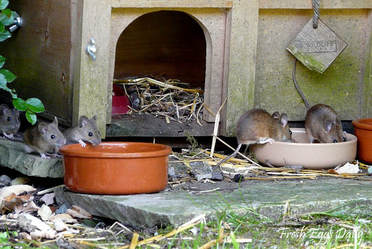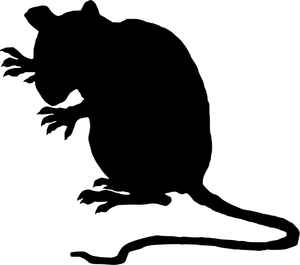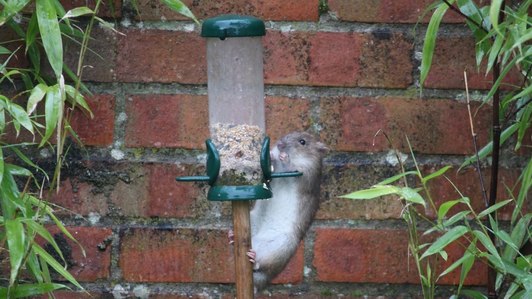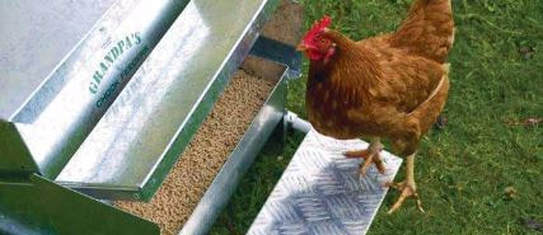Rodent ControlHelp! I've got rats!
Rat problems are better than they were in 2017, but the rats will always be among us. We need many neighbors to take individual actions to reduce rat food sources and rat nesting areas around their homes. The City will not solve this for us.
Since Friendly was overrun with rats in 2017, we devoted a special edition of our newsletter to rats (March 2018). Read it here. This information remains very useful. The city has rat prevention information on their website and created downloadable educational materials—articles, brochures, posters, social media posts. Rats may have hit a peak population in 2017 within Eugene—particularly in the Friendly neighborhood—due to an increasingly abundant food supply from composting food waste, raising chickens, fruit trees, bird feeders, and household pets. And our old sewer lines in south Eugene also play a part. The tide turned in 2018 as more neighbors took individual actions in their yards and homes to deter rats. If we keep working on rat control, we will keep them at bay. Rats evolved with humans, and we will always have them. We can move toward peaceful coexistence by being smart about how we manage the space around our homes. Rodents are a public health risk because they spread disease. • Rats eat everything! • Rats climb, jump, and swim. If a squirrel can climb it, a rat can climb it. • Rats chew through plastic, wood, soft metals, electrical wires (sometimes causing fires) and even cinder block, brick, and concrete sewer pipe. • Rats squeeze into tiny spaces and nest where it is dark and warm. How do I know if I have rats?Decision tool: figure out what to doUse this flow chart to figure out how to proceed with your rat situation and which government agencies offer help.
Navigating government resourcesLocal government response to rats is dispersed over numerous government agencies. It’s a challenge to decipher who has jurisdiction over which situation. Let this summary be your guide when you contact agencies for help, or to report a rat problem.
Eugene Planning: provides information about rat prevention and elimination at eugene-or.gov/rats. Direct questions or requests for more information about city educational outreach to Lindsay Selser, Communications Analyst: [email protected] or 541-682-6021. Eugene Public Works: responds to rat complaints in our sanitary sewer system. The sewer system is designed to be closed, but rats can enter the system via breaks in sewer pipes under city streets and between the city system and sewer pipes to homes and businesses. If someone has a rat problem at their home, they may notify Public Works at (541) 682-4800. Within 48 hours, this department will check for rat activity in the nearby sewer system, and place rat bait if appropriate. They will not bait again if there is already bait in the manhole. The sewer is separate from the city stormwater system. It is not safe to place poisons in the open stormwater system, since it drains directly to streams. Eugene Code Compliance: responds to complaints about rats on private property. Staff will conduct a field investigation to confirm the complaint and determine a food source or other conditions contributing to the problem. Staff contact the owner(s) and work to resolve the issue—either through education or, if needed, the formal enforcement process. Enforcement can follow a number of steps depending on each situation. Typically staff will continue to work with the owner to reach voluntary compliance. If this fails, a Notice to Correct is issued, giving the owner a specific number of days to correct code violations. Contact this office at (541) 682-5819 or file a complaint at pdd.eugene-or.gov/CodeCompliance/ComplaintStart. Lane County Health Department: through its Environmental Health section, conducts regular public health inspections of restaurants, food carts, food booths, school cafeterias, and day cares. The presence of active pest control measures within a business’ food safety plan is part of the inspection. To report rat sightings at the above types of businesses (those where food is served), call (541) 682-4480. Oregon Department of Agriculture Food Safety: To report rat sightings at businesses that grow, process, or sell food retail (for example, grocery stores), contact ODA at (503) 986-4720. Reducing my rat population
Your yard may be your paradise, with a carefully tended vegetable garden, composting system, chickens, and pets. Unfortunately, rats may treat it as their paradise, too.
These practices can help keep rodents out of your home, yard, and neighborhood: Eliminate possible outdoor food sources. Keep pet food stored outside in thick plastic or metal containers with tight lids, and don't leave pet food and water bowls out overnight. Keep outside cooking areas and grills clean. Pick up and dispose of pet droppings. Keep bird feeders away from the house, and use squirrel guards to limit access to the feeder by squirrels and other rodents. For kitchen food waste, use one of these rat proof options:
Eliminate nesting sites (harborage). Elevate hay, woodpiles, and garbage cans at least a foot off the ground. Move wood piles as far from the house as possible. Dispose of old vehicles, furniture, and tires. Keep grass and shrubbery near your home trimmed. Feed the chickens, not the rats. As with pet food, store chicken feed in secure containers and regularly clean up food on the ground. Put out only enough feed that will be eaten in 15 minutes. Or, consider investing in a secure feeding system, such as a treadle feeder. If you use straw as bedding, clean and aerate it regularly. Seal up holes inside and outside your home, garage, and outbuildings to prevent entry. Mice can squeeze through a nickel-size hole, and rats can fit through spaces the size of a half dollar. Look for gaps under and inside kitchen cabinets; under and behind the refrigerator and stove; inside closets; near the fireplace; around doors and windows; around pipes and vents under sinks and to the washer, dryer, water heater, and furnace; and in the attic and basement or crawl space. Use lath screen, cement, or metal sheeting to seal off large holes, and fill small holes with steel wool. Rodent Facts
Further reading
|

